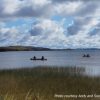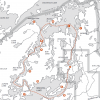From Rails to Whales: An 1,800 Mile, 86 Day Journey by Canoe from the Rocky Mountains to Hudson Bay
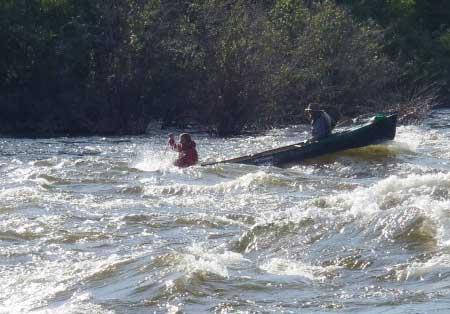
Having fun and running with an empty boat. Adam in stern, Ryan in bow. Birch Rapids, Saskatchewan. Photo by Jake.
By Adam Maxwell
View 8riversnorth’s profile on EveryTrail
Our journey began in the middle of May as Ryan Ritter, Jake Bendel and I drove north with a car full of gear and the spirit of adventure in our souls. The goal was to leave the Rocky Mountains and Jasper, Alberta, Canada, behind to traverse 1,800 miles of water before reaching the beluga whales at Hudson Bay. The route entailed many diverse and unique sections as it crossed three provinces via the Athabasca, La Biche, Beaver and Churchill Rivers. Unlike most groups traveling the northland ours was made up of an odd number of paddlers, with Jake deciding to kayak the route, while Ryan and I canoed. Another unique part of this route was the travel means, which did not include a plane or boat ride.
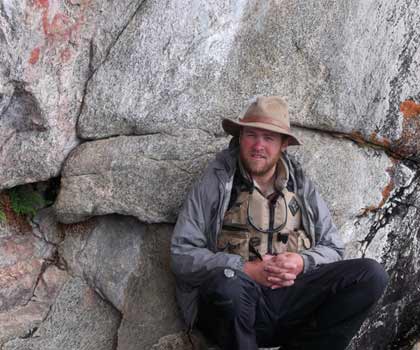
Adam Maxwell. Photo by Ryan.
Route Information
We first got on the water in Jasper, Alberta after a half mile portage from the train station to the Athabasca River. The river was the fastest flow we experienced all trip. With the exception of two very shallow lakes, it consisted of roughly two hundred miles of relatively small rapids. Shortly after leaving the scenery of the Rocky Mountains the river began to slow as we followed it another two hundred and fifty miles to the confluence of the La Biche River.
Our next challenge was to travel sixty miles upstream as we fought against the La Biche River flow. It began with several very tough days of tracking and dragging our boats up a current that was too fast to paddle. After 30 miles of this the river slowed and it felt great to actually be paddling again. At the end of this stained, brush filled river we entered Lac La Biche, a large and open lake that marked our entrance into the Hudson Bay watershed.
The following river had very different scenery than most people picture when they think of Canadian canoe trips. The Beaver River is a slow and meandering river which crosses a large portion of Saskatchewan farm country. Among the many bear and moose we encountered during this section was an endless number of grass fed cattle. This “lazy” river took us nine days to paddle before we entered the mighty Churchill.
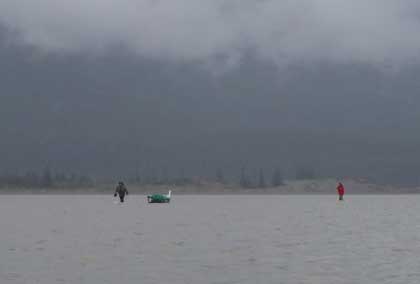
Jasper Lake is too shallow to paddle. Adam (left) and Ryan Ritter (right). Photo by Jake.
From here on out our travel would be on the Churchill River for almost a thousand miles before it flowed into Hudson Bay in Churchill, Manitoba. The Churchill was a gorgeous river that took us though a spruce lined portion of the Canadian Shield. The upper section of the river was primarily lakes connected by rapids and small sections of river. This was great as it provided both great lake paddling as well as a chance to test our whitewater skills. In many cases the rapids were short and had maintained portages around them before they dumped into the next lake. This allowed us to portage our gear and run some rapids with relatively low risk of harm.
After crossing South Indian Lake, the largest lake of our trip, we began the wildest and most difficult portion of our journey. This section had very few portage trails over its many rapids, some of which we were unable to run and required a bit of bushwhacking or lining. This section was the highlight of our trip for many reasons, including the sense of true wilderness that we experienced as we traveled a seemingly unexplored region.
As we neared the end of the final section it brought a bitter sweet feeling to the crew. It was great to be nearing our goal, yet none of us wanted to leave behind the sense of belonging we had felt on the rivers and in the wilderness. The realization that we had no where left to paddle began to leave a question in our minds of what was next, both in our arrival back to civilization and in our future river trips.
Our final day of paddling was one of my favorite days on the water. It started very early as we paddled into the bright orange of a great sunrise. As we neared Hudson Bay we were greeted by seals and eventually large groups of beluga whales. We were surrounded and followed by a welcome party of hundreds of whales. It was a surreal experience to watch animals the size of our boats swimming just inches away from us. It was an amazing ending to a great summer that left us all grinning from ear to ear.
Trip Planning
Planning for this trip began in the fall of 2011 with the idea of traveling with four guys in two canoes. However, as our departure date grew closer we had still not found a fourth paddler. This lead to the idea of changing our plans to include taking a 14 foot Prijon kayak and an 18 foot Wenonah Champlain. Ryan Ritter and I paddled the canoe, while Jake Bendel was the loan paddler in the kayak. This left many concerns about carrying gear, the boats keeping pace, safety in rapids and rescues, ease of portages and the group dynamic brought on by a solo paddler.
The kayak excelled in many ways. It was able to carry the equivalent of one overflowing number four Duluth pack. This is obviously much less than a canoe can hold, but it was enough to allow the canoe to carry the rest of our food and gear. Being shorter than a sea kayak and longer than a whitewater kayak, it also handled well in most conditions and kept pace with the canoe very well.
When it came to portaging, the kayak had both advantages and disadvantages. On many short portages or portages with log rollers, Jake pulled the boat over still loaded, resulting in the portages being easier than in a canoe. On the longer portages Jake had to load all the dry bags into a larger pack, and then reload his kayak after the portage. As expected this was a time consuming hassle.
Perhaps the largest concern of our three person group was from a group dynamics stand point. The concern was in the style of travel with two members paddling together, in one boat, while the other was paddling solo. In many groups this could have created some issues; however it suited our group well.
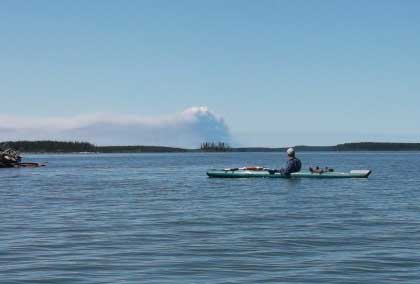
Large forest fire on Barrington River. Jake on South Indian Lake, Manitoba. Photo by Adam.
Trip Expenses
The three major expenses of traveling in the far north are always food, transportation and equipment. The goal of our trip was to reduce these expenses without limiting how far north we could go. Thus we planned to travel by trains rather than planes. Because that Churchill is the northern most train stop it appeared to be our best spot to end our paddle. After establishing this I began to research rivers that both crossed the train tracks and more or less flowed downriver to Churchill. Jasper was a great starting point for this reason, plus it had the added bonus of allowing us to paddle in the mountains.
Another huge help in planning was a connection with some friends that allowed us to leave a vehicle in Winnipeg. After driving to Winnipeg my vehicle stayed there all summer. From Winnipeg we boarded a train to Jasper and got on the water. After reaching Churchill we trained to Winnipeg and loaded the waiting vehicle before heading home.
We were also able to cut our budget by eating only food that could be bought in a standard grocery store. Our diet consisted mainly of oatmeal, trail mix, beans, noodles, peanut butter, rice and snack bars. Because we did not have to portage for nearly 900 miles at the start of our trip we were also able to bring a lot of food from home. For the first 40 days food costs were about seven dollars per person per day. Later in the trip as we began to buy food in small towns along our route, transportation cost lead to an increase in food cost to twelve dollar per person per day to eat.
Our summer was one of continuous excitement. The constant mystery of what lies around the next river bend fueled our desire to paddle and resulted in a grand adventure. It was extraordinary in many ways, yet it was also a trip that many paddlers could travel and more paddlers should travel. It was a route that is ideal for many young folks like us who have plenty of time and little money. The sense of freedom and self reliance that a person takes away from a prolonged period of time in nature is something that is not easily duplicated. The experience has altered and improved our crew’s outlook preceding the adventure. It created an opportunity for us to evaluate ourselves in a relaxed environment and allowed the time for us to realize what we valued in life. If you’ve ever dreamed of spending a summer paddling down a river, I encourage you to seize the day, load your boat and find out where one of the many wild rivers of the north will lead you.
Read the first story and see more photos: Rails to Whales 2012 >
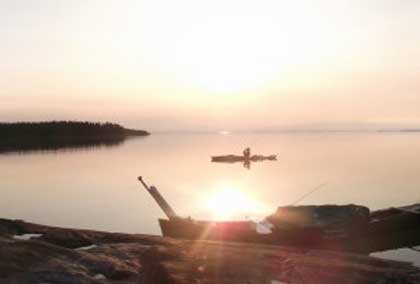
Gorgeous sunset after a long day’s paddle. Lac Ile a La Crosse, Saskatchewan. Photo by Ryan.



